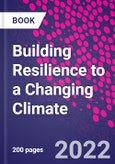This book will appeal to researchers and practitioners in a number of fields, especially those concerned with climate risks to humans, communities and social infrastructure.
Table of Contents
1. Equipping your toolbox with a cross-sectoral compass2. Promoting adaptive management and institutional risk taking
3. Leading with health, equity and inclusivity
4. Moving beyond the conventional risk mitigation model
5. Using a strengths-based, trauma-informed approach
6. Ensuring meaningful community engagement
7. Selecting strategies that build resilience to multiple climate stressors
8. Implementing with the power of partnerships
9. Sharing your collective success
10. Evolving the practice








